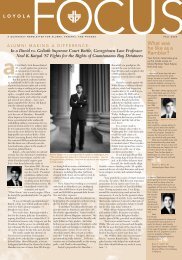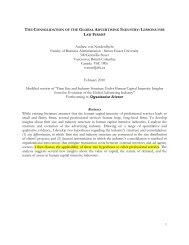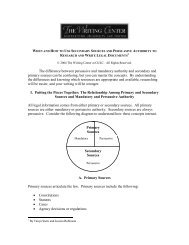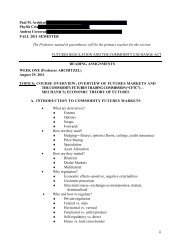Date: April 12, 2013 Topic: The Shrinking ... - Georgetown Law
Date: April 12, 2013 Topic: The Shrinking ... - Georgetown Law
Date: April 12, 2013 Topic: The Shrinking ... - Georgetown Law
You also want an ePaper? Increase the reach of your titles
YUMPU automatically turns print PDFs into web optimized ePapers that Google loves.
the marketing concept or market(ing) orientation. 33 Little marketing used to occur in the<br />
legal profession, and lawyers began to adopt marketing “unenthusiastically” or not at<br />
all. 34<br />
It has been argued that, from a microeconomic point of view, a law firm is<br />
essentially a service business like any other: it renders services to clients from whom it<br />
receives payment. 35 Like any other business, a law firm combines resources in order to<br />
produce services and adheres to the basic principles of economics—profitability and<br />
financial liquidity, to ensure continuity. <strong>The</strong> “growth in the size of the profession, the size<br />
of firms, and the volume of the market, has led . . . [to] lawyers having to treat the<br />
practice of law as a business.” 36 Access to justice requires not only that the legal advice<br />
given be sound, but also “the presence of the business skills necessary to provide a costeffective<br />
service in a consumer-friendly way.” 37 Customers are the lifeblood of any<br />
commercial organization. Without them, a business has no revenues, no profits, and<br />
therefore no market value. In fact, the basis of a business is its ability to create and keep a<br />
customer. 38 “[T]he law is a service business, and satisfaction can only be measured by the<br />
client.” 39 As the satisfaction of customer needs is the main business goal, businesses have<br />
only two basic functions, or processes, that are performed to carry out their mission:<br />
marketing and innovation. 40 Nevertheless, lawyers historically have not embraced<br />
marketing. Marketing was almost non-existent among lawyers as it was not only<br />
“disliked,” but also considered “profoundly unprofessional and inappropriate.” 41 While<br />
these observations are now dated, the strong influence of tradition and history in the legal<br />
profession, the perception of and the attitude towards marketing were substantial barriers<br />
to the advance of marketing in this field.<br />
By comparison, the UK’s Legal Services Act has focused investors on the<br />
sizeable opportunity that exists to create powerful brands in an industry which has grown<br />
up without them. At a consumer level, new UK entrants such as Quality Solicitors and<br />
Cooperative Legal Services are plowing huge sums of money into brand creation and<br />
management in an attempt to gain early-mover advantage. Riverview <strong>Law</strong> was the first<br />
commercial firm to launch after the UK liberalization fully took effect, and is similarly<br />
seeking to capitalize on the absence of household brands in the B2B arena and hoping to<br />
establish itself as the “go-to” firm for fixed-fee value-based legal services. More details<br />
of its approach can be found in the case study below. Being a very early mover,<br />
LegalZoom executives learned early that brand was particularly important in online legal<br />
services. <strong>The</strong> company reported marketing and sales spending of over $30 million in<br />
33. See Lloyd C. Harris & Nigel F. Piercy, Barriers to Marketing Development in the Barristers’ Profession, SERV. INDUS. J., Oct. 1998, at 19, 20;<br />
see also WERNER PEPELS & BRUNHILDE STECKLER, ANWALTS-MARKETING [LAWYER MARKETING] 2 (2003); Angela Vickerstaff, Legal Sector<br />
Marketing: A Contested Case, 38 MGMT. DECISION 354, 356 (2000). "Market orientation" is a strategic worldview whereby a firm focuses on its<br />
selected client base (its "market") in all it does. Serving that market is the focal goal of all functions in the business. <strong>The</strong> market, i.e. the clients, is<br />
the organizing principle for the firm and information about clients is used at all levels across all functions to steer the company in the right<br />
direction. “Marketing orientation,” as truly distinct from market orientation, is more tactical: in a marketing oriented firm, the marketing function<br />
has the power and drives the company ethos and pecking order. E.g., the firm might have a tradition of hiring leadership from the marketing<br />
function.<br />
34. See Lisa O’Malley & Lloyd C. Harris, <strong>The</strong> Dynamics of the Legal Market: An Interaction Perspective, EUR. J. MKTG. 874, 875 (1999).<br />
35. See PEPELS & STECKLER, supra note 3, at 1.<br />
36. STEPHEN MAYSON, MAKING SENSE OF LAW FIRMS 15 (1997) [hereinafter MAYSON, MAKING SENSE].<br />
37.<br />
SIR DAVID CLEMENTI, REVIEW OF THE REGULATORY FRAMEWORK FOR LEGAL SERVICES IN ENGLAND AND WALES 5 (2004) [hereinafter<br />
CLEMENTI, REVIEW] available at http://www.jambar.org/clement_report.pdf.<br />
38.<br />
See PETER F. DRUCKER, MANAGEMENT, TASKS, RESPONSIBILITIES, PRACTICES 20 (1974); see also THEODORE LEVITT, THE MARKETING<br />
MODE 10 (1969). Both sources emphasize the importance of focusing on the customer, and hence, the importance of marketing within any<br />
organization.<br />
39. John O. Cunningham, Getting the Most Out Of Outside Counsel 4 MIDWEST IN-HOUSE 1, 25 (2007).<br />
40. See DRUCKER, supra note 9, at 20.<br />
41. See Harris & Piercy, supra note 3, at 20.<br />
7
















